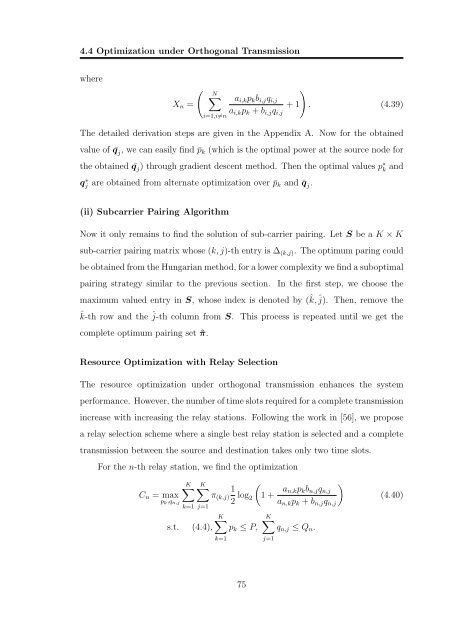Resource Allocation in OFDM Based Wireless Relay Networks ...
Resource Allocation in OFDM Based Wireless Relay Networks ...
Resource Allocation in OFDM Based Wireless Relay Networks ...
Create successful ePaper yourself
Turn your PDF publications into a flip-book with our unique Google optimized e-Paper software.
4.4 Optimization under Orthogonal Transmission<br />
where<br />
X n =<br />
( N<br />
∑<br />
i=1,i≠n<br />
a i,k p k b i,j q i,j<br />
a i,k p k + b i,j q i,j<br />
+ 1<br />
)<br />
. (4.39)<br />
The detailed derivation steps are given <strong>in</strong> the Appendix A. Now for the obta<strong>in</strong>ed<br />
value of ¯q j , we can easily f<strong>in</strong>d ¯p k (which is the optimal power at the source node for<br />
the obta<strong>in</strong>ed ¯q j ) through gradient descent method. Then the optimal values p ∗ k and<br />
q ∗ j are obta<strong>in</strong>ed from alternate optimization over ¯p k and ¯q j .<br />
(ii) Subcarrier Pair<strong>in</strong>g Algorithm<br />
Now it only rema<strong>in</strong>s to f<strong>in</strong>d the solution of sub-carrier pair<strong>in</strong>g. Let S be a K × K<br />
sub-carrier pair<strong>in</strong>g matrix whose (k, j)-th entry is ∆ (k,j) . The optimum par<strong>in</strong>g could<br />
be obta<strong>in</strong>ed from the Hungarian method, for a lower complexity we f<strong>in</strong>d a suboptimal<br />
pair<strong>in</strong>g strategy similar to the previous section. In the first step, we choose the<br />
maximum valued entry <strong>in</strong> S, whose <strong>in</strong>dex is denoted by (ˆk, ĵ). Then, remove the<br />
ˆk-th row and the ĵ-th column from S. This process is repeated until we get the<br />
complete optimum pair<strong>in</strong>g set ˆπ.<br />
<strong>Resource</strong> Optimization with <strong>Relay</strong> Selection<br />
The resource optimization under orthogonal transmission enhances the system<br />
performance. However, the number of time slots required for a complete transmission<br />
<strong>in</strong>crease with <strong>in</strong>creas<strong>in</strong>g the relay stations. Follow<strong>in</strong>g the work <strong>in</strong> [56], we propose<br />
a relay selection scheme where a s<strong>in</strong>gle best relay station is selected and a complete<br />
transmission between the source and dest<strong>in</strong>ation takes only two time slots.<br />
For the n-th relay station, we f<strong>in</strong>d the optimization<br />
C n = max<br />
p k ,q n,j<br />
K<br />
∑<br />
K∑<br />
k=1 j=1<br />
s.t. (4.4),<br />
(<br />
1<br />
π (k,j)<br />
2 log 2 1 + a )<br />
n,kp k b n,j q n,j<br />
a n,k p k + b n,j q n,j<br />
K∑<br />
p k ≤ P,<br />
k=1<br />
K∑<br />
q n,j ≤ Q n .<br />
j=1<br />
(4.40)<br />
75

















